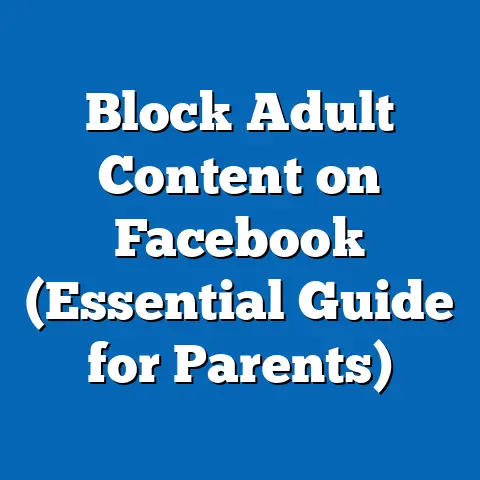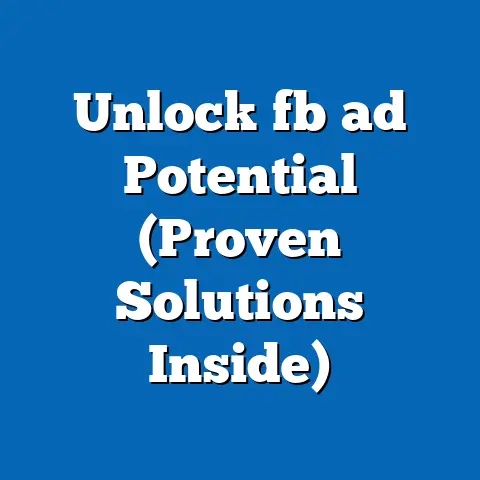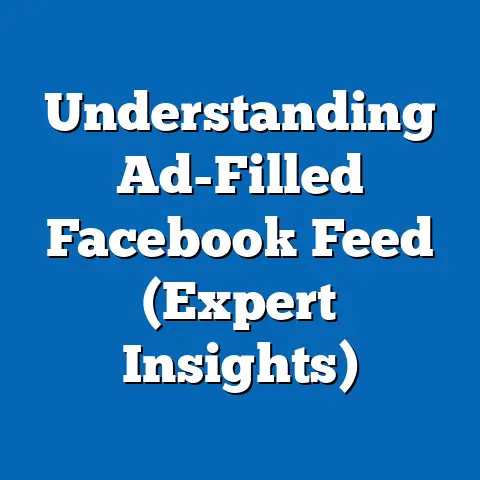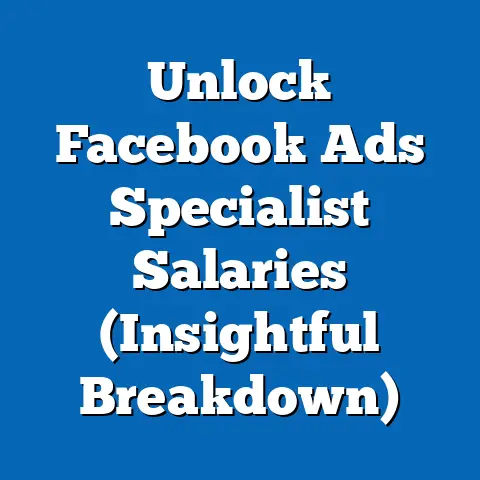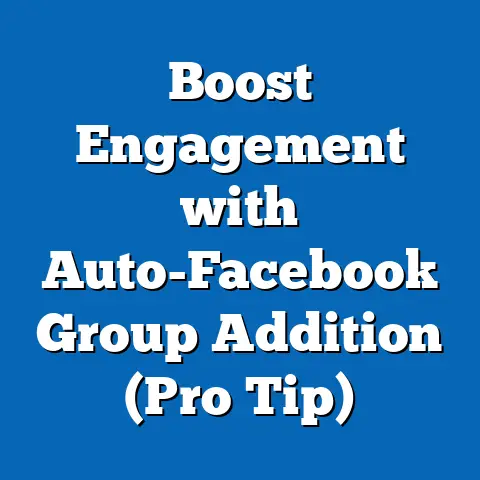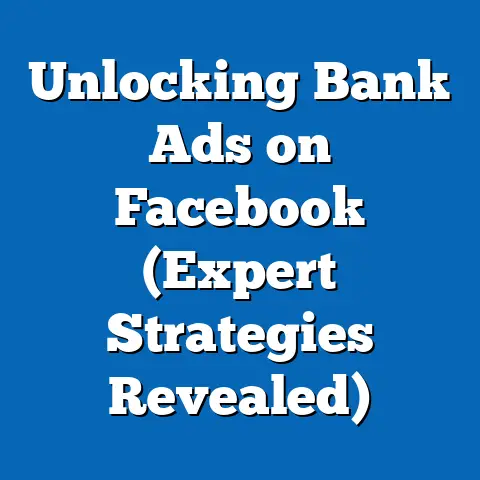Maximize Engagement with Slideshow Facebook Ads (Pro Tips)
I remember one spring, my allergies were so bad I could barely function. Pollen was my nemesis, turning a beautiful season into a constant battle of sneezing, watery eyes, and a general feeling of malaise. I tried everything – over-the-counter meds, nasal sprays, even those weird neti pots. Some things helped a little, but nothing truly solved the problem until I found a combination of strategies that worked for me.
Businesses often face a similar challenge in the digital world. They’re trying to reach their audience, cut through the noise, and get them to engage. It’s like battling a constant onslaught of information, and finding the right strategy can feel like searching for a cure for allergies. In the crowded landscape of Facebook advertising, grabbing attention can be tough. But fear not! Just as I found relief from my allergies, you can find a powerful tool to boost engagement: slideshow ads.
This article is your guide to creating compelling and engaging slideshow ads on Facebook. I’ll share pro tips, real-world examples, and actionable strategies to help you connect with your audience and achieve your advertising goals.
Understanding Slideshow Ads
Definition and Purpose
Slideshow ads on Facebook are a dynamic and engaging ad format that combines multiple images or videos into a single ad unit. Think of them as mini-movies or animated stories that unfold right in the newsfeed. Unlike static image ads, they offer a more immersive experience, and unlike full-fledged video ads, they’re much lighter on resources.
The primary purpose of slideshow ads is to capture attention and tell a story in a visually appealing way, without requiring the hefty investment of time and resources needed for video production. They are designed to be lightweight, easily digestible, and highly shareable, making them perfect for a wide range of businesses and advertising goals.
I’ve found that slideshow ads are particularly effective for:
- Product showcases: Displaying multiple angles or features of a product.
- Brand storytelling: Sharing the brand’s history, values, or mission.
- Customer testimonials: Featuring positive reviews in a visually engaging format.
- Event promotions: Highlighting key moments and activities from an event.
- Explaining complex topics: Breaking down information into easily digestible visuals.
Why Slideshow Ads?
In my experience, the advantages of using slideshow ads are numerous, especially when compared to other ad formats. Here are a few key reasons why I recommend them:
- Lightweight and Fast Loading: Slideshow ads are significantly smaller in file size than video ads. This means they load quickly, even on slower internet connections. This is crucial for mobile users who might not have access to high-speed data.
- Easy to Create: You don’t need expensive equipment or advanced editing skills to create compelling slideshow ads. Facebook’s Ads Manager provides intuitive tools that allow you to create slideshows from existing images or videos.
- Cost-Effective: Since they require fewer resources than video ads, slideshow ads are a budget-friendly option for businesses of all sizes. You can achieve high engagement without breaking the bank.
- Versatile: Slideshow ads can be used for a variety of purposes, from driving traffic to your website to generating leads or promoting your brand.
- Engaging: By combining multiple visuals and text, slideshow ads can capture attention and keep viewers engaged for longer than static image ads.
- Mobile-Friendly: Slideshow ads are optimized for mobile devices, ensuring a seamless viewing experience for your target audience.
- Increased Reach: Because of their lightweight nature and engaging format, slideshow ads tend to perform well in terms of reach and impressions. Facebook’s algorithm often favors content that is engaging and easy to consume.
Takeaway: Slideshow ads offer a sweet spot between static images and full-fledged videos. They’re easy to create, cost-effective, and highly engaging, making them a valuable addition to your Facebook advertising toolkit.
Crafting Compelling Content for Slideshow Ads
Creating a slideshow ad that truly resonates with your audience requires more than just slapping together a few pretty pictures. It’s about crafting a compelling narrative and choosing visuals that evoke emotion and drive action.
Choosing the Right Images
The images you use in your slideshow ad are the foundation of its success. Here are some tips for selecting the right visuals:
- High Quality is Key: Always use high-resolution images that are clear, crisp, and visually appealing. Blurry or pixelated images will turn viewers off immediately.
- Relevance Matters: Choose images that are directly relevant to your product, service, or message. Don’t use generic stock photos that don’t align with your brand.
- Showcase Benefits, Not Just Features: Instead of simply showing what your product looks like, focus on showcasing the benefits it provides. For example, if you’re selling a fitness tracker, show people using it to achieve their fitness goals.
- Use a Variety of Shots: Include a mix of wide shots, close-ups, and action shots to keep the slideshow visually interesting.
- Consider Your Target Audience: Choose images that resonate with your target audience’s interests, values, and aspirations.
- Brand Consistency: Ensure that the images you use are consistent with your brand’s visual identity, including color schemes, fonts, and overall aesthetic.
Where to Source Images:
- Original Photography: If possible, use your own original photography. This will give your slideshow ads a unique and authentic feel.
- Stock Photo Sites: If you don’t have access to original photography, there are many excellent stock photo sites available, such as Unsplash, Pexels, and Shutterstock. Just be sure to choose images that are high quality and relevant to your brand.
- User-Generated Content: Encourage your customers to share photos of themselves using your products or services. This is a great way to create authentic and engaging content.
Creating a Cohesive Narrative
A slideshow ad is essentially a mini-story, and like any good story, it should have a clear beginning, middle, and end. Here’s how to structure your slideshow to tell a compelling narrative:
- Start with a Hook: The first image or video clip should grab the viewer’s attention and make them want to keep watching. This could be a stunning visual, a thought-provoking question, or a compelling statistic.
- Introduce the Problem: Briefly introduce the problem or challenge that your product or service solves. This will help viewers understand why they should care about what you’re offering.
- Present the Solution: Show how your product or service can help solve the problem. Highlight the key benefits and features in a visually appealing way.
- Build Trust and Credibility: Include customer testimonials, case studies, or social proof to build trust and credibility.
- End with a Call to Action: Tell viewers what you want them to do next, whether it’s visiting your website, making a purchase, or signing up for a free trial.
Themes and Narratives That Work Well:
- Product Showcases: Highlight the key features and benefits of your product in a visually appealing way.
- Customer Testimonials: Share positive reviews from satisfied customers.
- Behind-the-Scenes Look: Give viewers a glimpse into your company culture or production process.
- How-To Tutorials: Show viewers how to use your product or service to achieve a specific goal.
- Problem/Solution: Highlight a common problem and show how your product or service can solve it.
I once worked with a local bakery that wanted to promote their new line of gluten-free pastries. We created a slideshow ad that started with a shot of someone looking longingly at a display of delicious-looking pastries, followed by images of the bakery’s gluten-free offerings, and ended with a happy customer enjoying a pastry with a cup of coffee. The ad told a simple story, but it effectively communicated the bakery’s message and drove traffic to their store.
Takeaway: A well-crafted narrative is essential for creating engaging slideshow ads. By structuring your slideshow to tell a story, you can capture attention, build trust, and drive action.
Best Practices for Maximizing Engagement
Creating a great slideshow ad is only half the battle. You also need to optimize it for maximum engagement. Here are some best practices to keep in mind:
Optimal Length and Timing
The ideal length for a slideshow ad typically falls between 15 and 30 seconds. This is long enough to tell a compelling story but short enough to keep viewers engaged.
- Keep it Concise: Respect your audience’s time and get to the point quickly.
- Test Different Lengths: Experiment with different lengths to see what works best for your target audience.
- Consider the Platform: Keep in mind that attention spans tend to be shorter on mobile devices, so you might want to create shorter slideshow ads for mobile users.
Timing is also crucial:
- Analyze Audience Behavior: Use Facebook’s Audience Insights tool to identify when your target audience is most active on the platform.
- Experiment with Different Times: Test different posting times to see when your slideshow ads generate the most engagement.
- Consider Time Zones: If you’re targeting a global audience, be sure to take time zones into account.
Incorporating Text and Call-to-Action
Text overlays can be a powerful tool for complementing your visuals and conveying your message more effectively. However, it’s important to use text sparingly and avoid overcrowding your slides.
- Keep it Brief: Use short, concise phrases that highlight the key benefits of your product or service.
- Use a Clear Font: Choose a font that is easy to read and visually appealing.
- Consider Contrast: Ensure that the text contrasts well with the background image so that it’s easy to read.
- Mobile Optimization: Make sure that the text is large enough to be easily readable on mobile devices.
Call-to-Action (CTA):
A strong CTA is essential for driving action and achieving your advertising goals. Here are some examples of effective CTAs:
- Shop Now: Use this CTA to encourage viewers to visit your online store and make a purchase.
- Learn More: Use this CTA to direct viewers to a landing page with more information about your product or service.
- Sign Up: Use this CTA to encourage viewers to sign up for a free trial, newsletter, or webinar.
- Get Started: Use this CTA to encourage viewers to take the first step towards using your product or service.
- Contact Us: Use this CTA to encourage viewers to reach out to your sales team with questions or inquiries.
I always recommend A/B testing different CTAs to see which one performs best. You might be surprised at how much of a difference a simple change in wording can make.
Takeaway: Optimize your slideshow ads for engagement by keeping them concise, using clear text overlays, and including a strong call-to-action. Remember to test different approaches to see what works best for your target audience.
Leveraging Facebook’s Ad Tools
Facebook’s Ads Manager provides a wealth of tools and features that can help you optimize your slideshow ads for maximum engagement.
Targeting and Audience Insights
Targeting the right audience is crucial for the success of any Facebook ad campaign. Here are some targeting options to consider:
- Demographics: Target viewers based on age, gender, location, education, and other demographic factors.
- Interests: Target viewers based on their interests, hobbies, and activities.
- Behaviors: Target viewers based on their online behavior, such as their purchase history, website visits, and app usage.
- Custom Audiences: Create custom audiences based on your existing customer data, such as email lists or website visitors.
- Lookalike Audiences: Create lookalike audiences based on your existing customer data. This allows you to target viewers who are similar to your best customers.
Audience Insights:
Facebook’s Audience Insights tool provides valuable data about your target audience, including their demographics, interests, behaviors, and purchase habits. Use this data to tailor your slideshow ads for better engagement.
I once used Audience Insights to discover that my target audience was highly interested in sustainable living. I then created a slideshow ad that highlighted the eco-friendly aspects of my product, and it performed significantly better than my previous ads.
A/B Testing and Analytics
A/B testing is the process of testing two or more versions of your slideshow ad to see which one performs best. This is a great way to refine your strategies and optimize your ads for maximum engagement.
- Test Different Images: Experiment with different images to see which ones resonate most with your target audience.
- Test Different Headlines: Test different headlines to see which ones grab the most attention.
- Test Different CTAs: Test different CTAs to see which ones drive the most action.
- Test Different Targeting Options: Experiment with different targeting options to see which ones reach the most engaged viewers.
Analytics:
Facebook’s analytics tools provide detailed data about the performance of your slideshow ads, including impressions, reach, click-through rates, engagement levels, and conversion rates. Use this data to track your progress and identify areas for improvement.
Key Metrics to Track:
- Click-Through Rate (CTR): Measures the percentage of viewers who click on your ad.
- Engagement Rate: Measures the percentage of viewers who interact with your ad, such as liking, commenting, or sharing.
- Conversion Rate: Measures the percentage of viewers who take the desired action, such as making a purchase or signing up for a free trial.
- Cost Per Click (CPC): Measures the cost of each click on your ad.
- Cost Per Conversion (CPC): Measures the cost of each conversion that results from your ad.
Takeaway: Facebook’s Ads Manager provides a powerful suite of tools that can help you target the right audience, test different strategies, and track your progress. By leveraging these tools, you can optimize your slideshow ads for maximum engagement and achieve your advertising goals.
Real-World Examples and Case Studies
Let’s take a look at some real-world examples of brands that have successfully used slideshow ads to boost engagement:
Successful Slideshow Ad Campaigns
- GoPro: GoPro uses slideshow ads to showcase their action cameras in a variety of exciting settings. They use high-quality images and videos to capture the viewer’s attention and highlight the versatility of their products.
- Airbnb: Airbnb uses slideshow ads to promote their unique accommodations around the world. They use stunning visuals and compelling storytelling to inspire viewers to book their next vacation.
- Warby Parker: Warby Parker uses slideshow ads to showcase their stylish eyewear. They use a mix of product shots and lifestyle images to appeal to their target audience.
What Made These Campaigns Successful?
- High-Quality Visuals: All of these brands use high-quality images and videos that are visually appealing and engaging.
- Compelling Storytelling: They all tell compelling stories that resonate with their target audience.
- Clear Call-to-Action: They all include a clear call-to-action that tells viewers what they want them to do next.
- Targeted Advertising: They all target their ads to the right audience based on demographics, interests, and behaviors.
Common Pitfalls to Avoid
- Overcrowding Slides with Information: Avoid cramming too much text or information onto each slide. Keep it concise and easy to read.
- Neglecting Mobile Optimization: Make sure that your slideshow ads are optimized for mobile devices. This means using large fonts, clear images, and a simple layout.
- Using Low-Quality Images: Always use high-resolution images that are clear, crisp, and visually appealing.
- Failing to Tell a Story: Don’t just slap together a bunch of random images. Create a cohesive narrative that captures the viewer’s attention and keeps them engaged.
- Ignoring A/B Testing: A/B testing is essential for optimizing your slideshow ads for maximum engagement. Don’t be afraid to experiment with different images, headlines, and CTAs to see what works best for your target audience.
Takeaway: Learn from the successes and failures of other brands. Pay attention to what works and what doesn’t, and use this knowledge to create your own engaging and effective slideshow ads.
Conclusion
Just as I found relief from my allergies by combining different strategies, marketers can enhance their Facebook ad strategies with slideshow ads. They offer a powerful and cost-effective way to capture attention, tell a story, and drive action.
By following the pro tips discussed in this article, you can create compelling and engaging slideshow ads that resonate with your target audience and achieve your advertising goals. Remember to focus on high-quality visuals, compelling storytelling, clear calls to action, and targeted advertising. And don’t be afraid to experiment and test different approaches to see what works best for your brand.
So, go out there and start creating slideshow ads that will make your brand stand out from the crowd! Your audience is waiting to be engaged.

